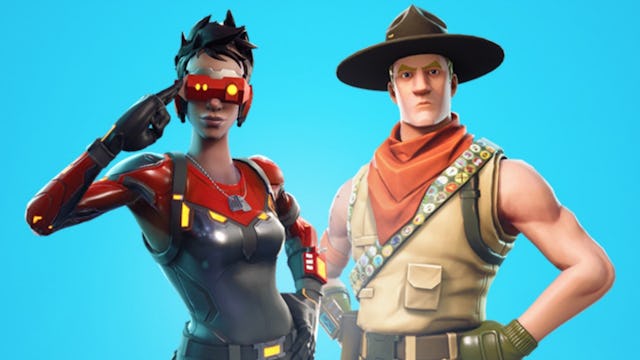No, We Don't Need To Worry About Kids Playing Fortnite, And Here's Why

Parents everywhere are concerned about Fortnite, the latest gaming trend. Right now, my 11-year-old son Leo is hooked up to his PS4 in our basement. The Fortnite battle wagon – Ms. Frizzle’s Magic School Bus meets the U.S. Army Airborne School – is about to drop him into the Wailing Woods where he’ll fight to survive. He hang-glides into a game of sudden death.
Some of Leo’s best friends aren’t allowed to play Fortnite Battle Royale, even if other moderate-minded mothers impose time limits instead. I get it – the no-tolerance policy. Generally speaking, video games have always unnerved me.
Even though I acquiesced, Mom vs. Leo is its own kind of Battle Royale.
I didn’t grow up with guns, never shot one, so whenever I glimpse the cross-hairs, magnified by the imagined rifle scope in, say, Call of Duty on my TV screen – especially when I’m in the midst of baking muffins or some other sentimentalized ritual associated with “good motherhood” – a grenade detonates inside my chest. What kind of parents are we, letting our kids simulate violence in an already savage world?
But after weeks of fuming as Leo raged in the basement, refusing to join us in the land of the living, I finally decided, over a really hot cup of coffee, that I’d watch him play Fortnite and decide if this obsession was worth my genuine worry.
The best parenting advice I ever received was to “react but not overreact.”
Unlike players in Call of Duty who immediately re-spawn upon being shot, characters in Fortnite don’t rise from the dead. Something here was different. Of course, players can always start another game, and they almost always do.
By the time I ventured downstairs, Leo had already used his $25 gift certificate from Grandma to slip through our plasma screen into a new skin, a costume he purchased using V bucks. With this create-your-own-character investment, he’d mutated into a rabbit resembling Bugs Bunny’s girlfriend Lola. In squad mode, Leo and his three buddies had to dodge or kill 96 other players far savvier than Elmer Fudd, all in pursuit of a “dub” or the Win. Headset lopsided over his head of curls, he shushed me, listening for footsteps of an oncoming attack. His character was wearing an Easter egg backpack.
“It’s an egg launcher,” he said, laughing. “It’s on sale for one day only.”
What big ears you have; the better to hear you with, my dear.
And then, as I was taking in the cartoon nature of it all, something happened that I didn’t expect. I was not, actually, alarmed. My son and I settled together into an unexpected cease-fire, even as he wielded a pickaxe on screen.
I could plainly see that Fortnite fosters collaboration. Leo’s squad member slipped him Slurp Juice, saving him from total demise. Together they resourcefully collected supplies to build bridges, ramps, walls, and forts that served as refuges. Leo, in his bunny costume, was a female protagonist – physically vigorous, agile, and courageous. He’d metaphorically slipped into a woman’s skin, believing her body made him strong.
And that’s what struck me most – the over-arching metaphors that Fortnite presents.
In the game, once players land on Tilted Towers or in Fatal Woods, the eye of a lethal storm shrinks the habitable landscape into smaller concentric circles. In calculated pulses, the earth becomes unsustainable, and players can’t survive beyond the border of this ever-shrinking ring. Imagine a telephoto lens; as you zoom in, scenery is eclipsed. What remains of the map is clouded over, a purple monsoon that asphyxiates its players, climate change at its most frightening. Irregular weather patterns mount to the tune of a countdown timer.
Meanwhile players, not unlike children in today’s schools, dodge bullets and run for cover. They’re not just shooting each other; they’re being attacked. Leo was six years old, a first-grader himself, when Adam Lanza opened fire at Sandy Hook Elementary School.
Fortnite is a microcosm of life as they know it. It’s their own version of the school-sponsored ALICE Training (Alert, Lockdown, Inform, Counter, and Evacuate). What kinds of fortresses might they build, if and when everyday life is suddenly a matter of life and death?
Maybe the Fortnite trend isn’t about simulating violence. Maybe it’s about bracing for it. With every “win” – or jubilation emote – these kids stockpile staying power. After all, if Fortnite doesn’t teach our children how to survive, who will?
This article was originally published on